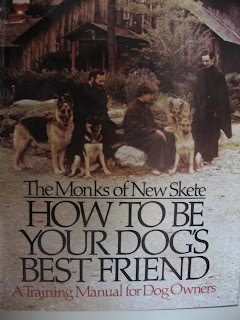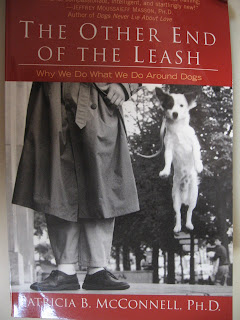
I showed you this book once already - "A Dog in Hand," by Dr. George Gates. It is not well known, and it should be. He has some theories on handling young puppies that are very similar to what I presented in Puppy Handling part 1 and part 2. Read this one for many practical tips and useful insights into dog behavior.
This link will take you to Ian Dunbar's Sirius Puppy Training site. He has excellent videos demonstrating positive reinforcement training techniques like I showed for Sit, Stand, and Down. Dr. Dunbar invented the concept of puppy "kindergarten" classes that promote socialization and teach basic manners, including bite inhibition, for puppies 2 to 5 months old, using food lures and praise.

Pretty much my "Bible" of dog training is Carol Lea Benjamin's "Mother Knows Best, the Natural Way to Train Your Dog." It's an old book, published in 1985 by Howell Book House, but still rings true today. Even though I practically have it memorized, I always re-read it when I get a new puppy. Her concept of Alpha equals Mother, not Dictator, and her simple line drawings illustrate each point with easy humor. She has several companions books, like "Dog Problems" and "Second Hand Dog" (about training a dog who comes with baggage) but read "Mother Knows Best" first.

Another classic is by the Monks of the New Skete Monastery, "How to be your Dog's Best Friend." The monks raise very high caliber German Shepherd Dogs in upstate New York, with an emphasis on physical and mental health and excellent behavior. This book was originally published in 1978 by Little, Brown. If you own or purchase a copy of this book, do me a favor: Go to page 47 and tear it out. This is the infamous "alpha roll," which should be outlawed, in my opinion. The primary author of the book, Job Michael Evans, said in later years he wished that technique had never been included in the book.
What's wrong with the "alpha roll?" Aside from the fact that it could get you seriously hurt if you did it to the wrong dog, and excluding the point that most people have no clue what they are doing and misuse it, the bottom line is dogs (or wolves) don't roll each other over. In wolves in the wild, even in dog society, a submissive animal offers the roll-over to signify his acceptance of a dominant animal's status. A respected leader doesn't go around knocking his subordinates over - it is beneath his dignity. When you roll your dog or puppy over and scream in his face, you look maniacal, like someone who should be feared or shunned, not like someone who should be trusted and followed.
So, drop the alpha roll-over from your repertoire immediately and as a matter of fact, be very careful with the "shake-down" demonstrated on page 45, too. I do use the shake technique with my very pushy, mouthy puppies who insist on biting me, but I pick and choose my cases carefully. I even used it on a 120 lb male Rottweiler in the exam room once. He needed an upper respiratory virus (kennel cough) vaccination which is given as nose drops, and he didn't want it. He was not being mean, just stubborn, and kept shaking his head back and forth ("no, no, no, no.") The owner, a strong man in his own right, was trying to hold him still, and the Rott was shaking him around the room like a rag doll. Finally, in frustration, I grabbed the dog by his jowls, lifted his front feet off the floor, gave him a firm shake, a hard eye, and a growl: "Quit it!" I set him down hard and he blinked once and looked completely dumb-founded. I proceeded to give him his vaccination without any holding, any head shaking, or any trouble.
I don't advocate that you try this with just any dog, and in retrospect, I told myself sternly what a stupid thing this was for me to have done. Had he been a mean or difficult dog, he could easily have killed me. I was lucky that I read the dog right and was appropriate in my level of correction, because to have been too hard or too soft on him would have made the matter worse. Still, I do have fond memories of that appointment.
Back to books:

Although "How to Be Your Dog's Best Friend" was credited to the entire monastery, the primary (pretty much only) author was a young monk named Job. After leaving the monastic life, Job Michael Evans moved to New York City and set up a dog training business, "The Patience of Job," based on the techniques he learned at New Skete. He wrote several books, including "The Evans Guide to Housetraining," "Civilized City Canines," and "The Evans' Guide for Counseling Dog Owners." He also gave seminars, and I was lucky enough to attend a two day class he gave in Cincinnati. My dog Joshua was a demo dog, and Job complimented Josh on his brains and training, even giving him a kiss on his forehead, at the "third eye," which Job said he reserved for dogs who had accomplished something special. I was very saddened when we lost this soft-spoken, gentle man to AIDS.
Don't let the title fool you: "Evans' Guide to Housetraining" is about more than when and where to go poo or pee. It is about nutrition and parlanguage and being alpha. The author says it best in his introduction: "Please don't view housetraining as an isolated process with one magic solution ..." something I tell every dog owner who asks me how to get Fido to stop barking, biting, jumping up or peeing on the carpet.

Jon Katz's book, "Katz on Dogs" (Don't you love that title?) isn't so much a training book - not a lot of "This is how you teach Down or Stay" - but a philosophy-of-training book. I know he has written several books, but this is the only one I have read so far. I like his style. He makes me feel like it is OK to mess up, that I won't ruin my dog if I make a mistake. So many people tell you to "always" or "never" do this or that, and Katz confesses that he is human and sometimes he does yell at his dog over nothing or punishes it when it comes back after having run away. Read Jon Katz and you will immediately feel better about yourself.

Elizabeth Marshall Thomas' book, "The Hidden Life of Dogs" is a fascinating look into what dogs do when we aren't around to control their every move. Although I oppose her method of study (letting dogs run loose and following them as they roam over 130 square miles is too fraught with potential danger in my opinion) it is amazing the things dogs do when they are on their own. Thomas also has experience with wolves and dingoes, and does a nice job of "compare and contrast" between the behaviors of three Canids.
 For the other side of the coin, read "The Other End of the Leash," by Patricia McConnell. I just finished this book and could hardly put it down. (I borrowed it, by the way, so Mom, Sis - if you need ideas for Christmas ...) This book is about why we do what we do when we interact with dogs, and how different the two species are. Just as dog training books are fond of saying "Dogs are wolves" (even though you and I both know there are many subtle, and some not-so-subtle, differences between the two,) McConnell asserts "People are chimpanzees" (again, with obvious differences.) We act like primates and dogs are canines - how we ever got together in the first place astounds me.
For the other side of the coin, read "The Other End of the Leash," by Patricia McConnell. I just finished this book and could hardly put it down. (I borrowed it, by the way, so Mom, Sis - if you need ideas for Christmas ...) This book is about why we do what we do when we interact with dogs, and how different the two species are. Just as dog training books are fond of saying "Dogs are wolves" (even though you and I both know there are many subtle, and some not-so-subtle, differences between the two,) McConnell asserts "People are chimpanzees" (again, with obvious differences.) We act like primates and dogs are canines - how we ever got together in the first place astounds me. One of my favorite examples from her book is her discussion on how we give our dogs commands. Remember back to Rule #3 of my Rules for Dog Training - "Dogs don't speak English" and it's corollaries: "Say it once," "Say it the same way," and "Say it softly." No matter how many times I tell a person that, I still hear "sit, Sit, SIT, SIT!" Why do we repeat ourselves and get louder each time, even when we know we shouldn't? Because we are primates, and when primates get excited, they repeat sounds over and over, with increasing volume. As humans, masters of the spoken language, we are proud of our wide vocabulary. Why use one word when 6 might be better? So, we say "Come," "C'mere," "Come over here," "Come here right now," and so on. Imagine if you were plunked down in the middle of a foreign land and someone kept on jabbering at you, with many different sounds and no hand gestures. Would you ever get the concept the stranger was trying to get across to you?
These and many, many other situations in her book struck home with me. If you would like a unique perspective on the human at the other end of the leash, read this book. But, be sure to bring along a sense of humor and be prepared to laugh at yourself.
Before you ask, yes, I have read the book by a popular TV dog trainer, and so far, haven't found it worthy of my library. It is mostly a rehash of the alpha concept, which is hardly new, with a fair amount of celebrity name-dropping, which doesn't impress me. One concept which I do find useful is the idea that our dogs need much more exercise than they get, and that the exercise should be structured. However, maybe one in 100 people could give their dogs the hours of daily exercise advocated in this book, and I suspect most people ignore this advice out of hand. The author's habit of taking a pack of dogs for a walk or roller-blading with dogs is ill-conceived. Maybe some people can do this, but I fear most cannot, and mayhem and injury are likely to occur if untrained owners attempt these tricks.
Looking for an end-of-summer read? Try some of these dog books, if you would like to understand your four-legged buddy.



2 comments:
Well, KatDoc--I think you have just about covered the subject.
All very helpful info. I wouldn't have had a clue where to begin.
Also interesting to read your take on the alpha roll issue. What you say makes a lot of sense to me.
"The Secret Life of Dogs" made me nervous...all that dog freedom. I couldn't help but think of a dog being out on it's own, free to get hit by a car, or wrestle with a bear, or get shot by a hillbilly....
I never saw the need to do the "alpha" roll, either. I assert my Mother Dog thing by other methods...The Darth Vader voice, pressure on the neck, etc. But I catch myself doing the "baby talk" voice and have to rein it in. : )
Post a Comment